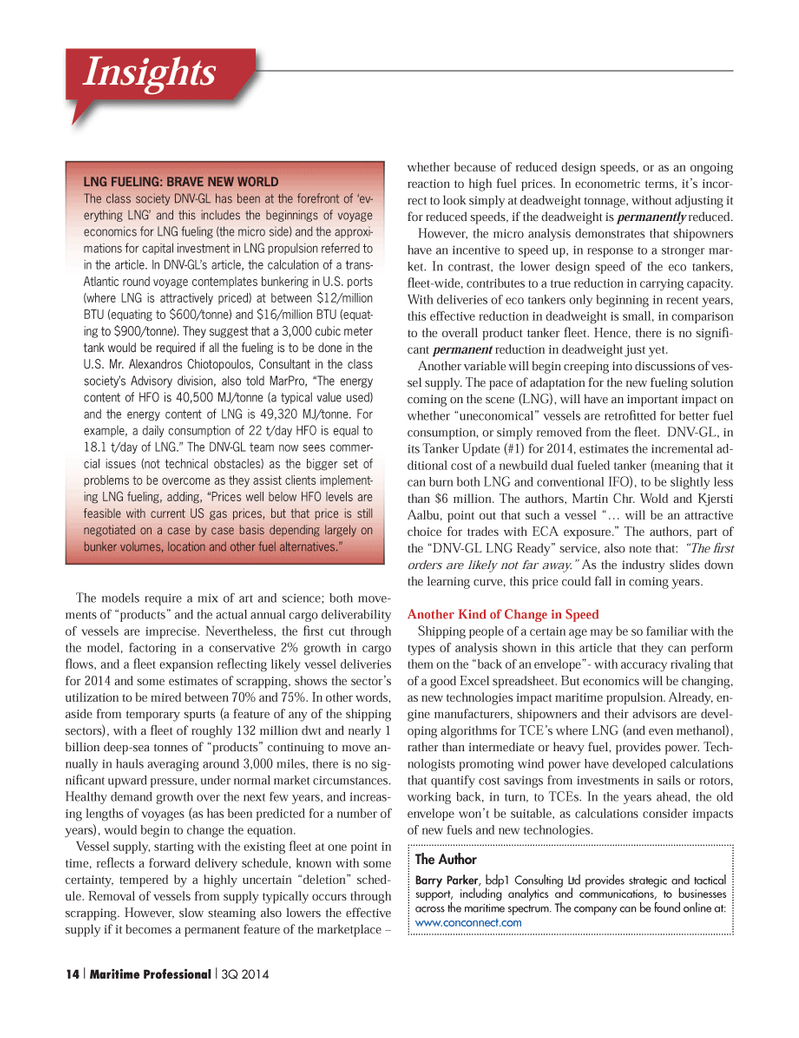
Page 14: of Maritime Logistics Professional Magazine (Q3 2014)
Power & Fuel Management
Read this page in Pdf, Flash or Html5 edition of Q3 2014 Maritime Logistics Professional Magazine
The models require a mix of art and science; both move- ments of ?products? and the actual annual cargo deliverability of vessels are imprecise. Nevertheless, the rst cut through the model, factoring in a conservative 2% growth in cargo ows, and a eet expansion re ecting likely vessel deliveries for 2014 and some estimates of scrapping, shows the sector?s utilization to be mired between 70% and 75%. In other words, aside from temporary spurts (a feature of any of the shipping sectors), with a eet of roughly 132 million dwt and nearly 1 billion deep-sea tonnes of ?products? continuing to move an- nually in hauls averaging around 3,000 miles, there is no sig- ni cant upward pressure, under normal market circumstances. Healthy demand growth over the next few years, and increas- ing lengths of voyages (as has been predicted for a number of years), would begin to change the equation. Vessel supply, starting with the existing eet at one point in time, re ects a forward delivery schedule, known with some certainty, tempered by a highly uncertain ?deletion? sched- ule. Removal of vessels from supply typically occurs through scrapping. However, slow steaming also lowers the effective supply if it becomes a permanent feature of the marketplace ? whether because of reduced design speeds, or as an ongoing reaction to high fuel prices. In econometric terms, it?s incor- rect to look simply at deadweight tonnage, without adjusting it for reduced speeds, if the deadweight is permanently reduced.However, the micro analysis demonstrates that shipowners have an incentive to speed up, in response to a stronger mar- ket. In contrast, the lower design speed of the eco tankers, eet-wide, contributes to a true reduction in carrying capacity. With deliveries of eco tankers only beginning in recent years, this effective reduction in deadweight is small, in comparison to the overall product tanker eet. Hence, there is no signi -cant permanent reduction in deadweight just yet.Another variable will begin creeping into discussions of ves- sel supply. The pace of adaptation for the new fueling solution coming on the scene (LNG), will have an important impact on whether ?uneconomical? vessels are retro tted for better fuel consumption, or simply removed from the eet. DNV-GL, in its Tanker Update (#1) for 2014, estimates the incremental ad- ditional cost of a newbuild dual fueled tanker (meaning that it can burn both LNG and conventional IFO), to be slightly less than $6 million. The authors, Martin Chr. Wold and Kjersti Aalbu, point out that such a vessel ?? will be an attractive choice for trades with ECA exposure.? The authors, part of the ?DNV-GL LNG Ready? service, also note that: ?The rst orders are likely not far away.? As the industry slides down the learning curve, this price could fall in coming years. Another Kind of Change in SpeedShipping people of a certain age may be so familiar with the types of analysis shown in this article that they can perform them on the ?back of an envelope?- with accuracy rivaling that of a good Excel spreadsheet. But economics will be changing, as new technologies impact maritime propulsion. Already, en- gine manufacturers, shipowners and their advisors are devel- oping algorithms for TCE?s where LNG (and even methanol), rather than intermediate or heavy fuel, provides power. Tech- nologists promoting wind power have developed calculations that quantify cost savings from investments in sails or rotors, working back, in turn, to TCEs. In the years ahead, the old envelope won?t be suitable, as calculations consider impacts of new fuels and new technologies. LNG FUELING: BRAVE NEW WORLD The class society DNV-GL has been at the forefront of ?ev- erything LNG? and this includes the beginnings of voyage economics for LNG fueling (the micro side) and the approxi- mations for capital investment in LNG propulsion referred to in the article. In DNV-GL?s article, the calculation of a trans- Atlantic round voyage contemplates bunkering in U.S. ports (where LNG is attractively priced) at between $12/million BTU (equating to $600/tonne) and $16/million BTU (equat-ing to $900/tonne). They suggest that a 3,000 cubic meter tank would be required if all the fueling is to be done in the U.S. Mr. Alexandros Chiotopoulos, Consultant in the class society?s Advisory division, also told MarPro, ?The energy content of HFO is 40,500 MJ/tonne (a typical value used) and the energy content of LNG is 49,320 MJ/tonne. For example, a daily consumption of 22 t/day HFO is equal to 18.1 t/day of LNG.? The DNV-GL team now sees commer-cial issues (not technical obstacles) as the bigger set of problems to be overcome as they assist clients implement- ing LNG fueling, adding, ?Prices well below HFO levels are feasible with current US gas prices, but that price is still negotiated on a case by case basis depending largely on bunker volumes, location and other fuel alternatives.?InsightsThe Author Barry Parker , bdp1 Consulting Ltd provides strategic and tactical support, including analytics and communications, to businesses across the maritime spectrum. The company can be found online at:www.conconnect.com 14 I Maritime Professional I 3Q 20141-17 Q3 MP2014.indd 141-17 Q3 MP2014.indd 148/13/2014 4:03:25 PM8/13/2014 4:03:25 PM

 13
13

 15
15
